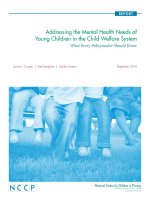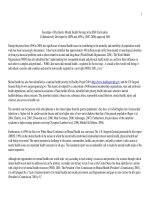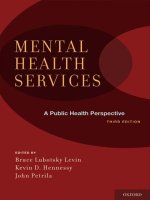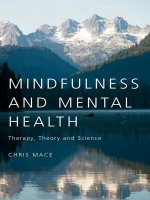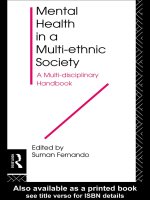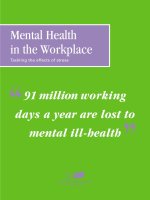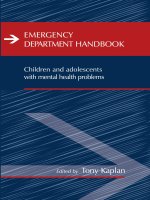EVIDENCE-BASED PRACTICE IN SCHOOL MENTAL HEALTH doc
Bạn đang xem bản rút gọn của tài liệu. Xem và tải ngay bản đầy đủ của tài liệu tại đây (1.75 MB, 364 trang )
EVIDENCE-BASED PRACTICE IN SCHOOL MENTAL HEALTH
OXFORD WORKSHOP SERIES:
SCHOOL SOCIAL WORK ASSOCIATION OF AMERICA
Series Advisory Board
Judith Shine, President
Susan L. Ellis, Executive Director
Randy A. Fisher
Stephen P. Hydon
Donna J. Secor
Evidence-Based Practice in School Mental Health
James C. Raines
The Domains and Demands of School Social Work Practice
Michael S. Kelly
Solution-Focused Brief Therapy in Schools
Michael S. Kelly, Johnny S. Kim, and Cynthia Franklin
EVIDENCE-BASED PRACTICE IN SCHOOL
MENTAL HEALTH
A Primer for School Social Workers,
Psychologists, and Counselors
James C. Raines
1
2008
OXFORD WORKSHOP SERIES
■■■
3
Oxford University Press, Inc., publishes works that further
Oxford University’s objective of excellence
in research, scholarship, and education.
Oxford New York
Auckland Cape Town Dar es Salaam Hong Kong Karachi
Kuala Lumpur Madrid Melbourne Mexico City Nairobi
New Delhi Shanghai Taipei Toronto
With offi ces in
Argentina Austria Brazil Chile Czech Republic France Greece
Guatemala Hungary Italy Japan Poland Portugal Singapore
South Korea Switzerland Thailand Turkey Ukraine Vietnam
Copyright © 2008 by Oxford University Press, Inc.
Published by Oxford University Press, Inc.
198 Madison Avenue, New York, New York 10016
www.oup.com
Oxford is a registered trademark of Oxford University Press
All rights reserved. No part of this publication may be reproduced,
stored in a retrieval system, or transmitted, in any form or by any means,
electronic, mechanical, photocopying, recording, or otherwise,
without the prior permission of Oxford University Press.
Library of Congress Cataloging-in-Publication Data
Raines, James Curtis.
Evidence-based practice in school mental health / James C. Raines.
p. cm.—(Oxford workshop series)
Includes bibliographical references and index.
ISBN 978-0-19-536626-6
1. School children—Mental health services. 2. School social work—United States.
3. Evidence-based social work—United States. 4. Evidence-based
psychiatry—United States. 5. Students with disabilities—Services for—United States.
I. School Social Work Association of America. II. Title. III. Series.
[DNLM: 1. School Health Services. 2. Adolescent. 3. Child. 4. Evidence-Based Medicine.
5. Mental Disorders—therapy. 6. Mental Health Services. WA 352 R155e 2008]
LB3430.R35 2008
371.7′130973 dc22 2008001223
1 3 5 7 9 8 6 4 2
Printed in the United States of America
on acid-free paper
v
Contents
Preface vii
Chapter 1 Introduction 3
Chapter 2 Evidence-Based Practice: De nition
and Process
25
Chapter 3 Creating Answerable Questions 45
Chapter 4 Investigating the Evidence 67
Chapter 5 Appraising the Evidence 103
Chapter 6 Adapting and Applying the Evidence 133
Chapter 7 Evaluating Group Outcomes Using Descriptive
Designs
163
Chapter 8 Evaluating Individual Outcomes Using
Single-Subject Designs
197
Chapter 9 Ethics for Evidence-Based Practice 221
Chapter 10 Systemic Change 255
Glossary 277
Appendix A Internet Resources for Evidence-Based
Practice
285
vi Contents
Appendix B Annotated Bibliography on Empirically Supported
Interventions
293
Appendix C Ten Threats to Internal Validity 295
References 297
Index 351
vii
Preface
Evidence-based practice has become a common expression in the helping
professions over the last decade. Beginning with medicine and moving to
fi elds such as psychology and social work, the number of books on evidence-
based practice has grown signifi cantly. What makes this book different? This
book is aimed at preservice and in-service school-based mental health ser-
vice providers, such as school counselors, school psychologists, and school
social workers. It is not a research book. It is a book about research-infused
practice. What does this mean? It means that this book aims to give school
service providers a pragmatic approach to informing every major practice
decision with the appropriate research so that students receive the best pos-
sible services. The book addresses how to use research to make reliable and
valid assessments, how to use research to choose the best intervention, and
how to use research to evaluate student progress.
Estimates of child and adolescent mental health problems range from
10% to 20% (Roberts, Attkinson, & Rosenblatt, 1998). The best estimate
is that at least 10% of youths suffer from serious behavioral or emotional
problems (National Advisory Mental Health Council, 2001). If there are
70 million school-age children in the United States (Kazdin, 2003), then at
least 7 million need help. Unfortunately, up to 70% of these children never
receive any mental health services. Of those who do get help, schools are the
primary providers (Burns et al., 1995; Rones & Hoagwood, 2000).
Child and adolescent psychotherapy has not always had a history of being
effective. Levitt (1957) came to the conclusion that children who received
treatment were no better off than those who did not. By the year 2000,
however, approximately 1,500 outcome studies have been completed on
youth treatment (Durlak, Wells, Cotton, & Johnson, 1995; Kazdin, 2000).
The later studies have overcome earlier methodological weaknesses and
demonstrated signifi cantly stronger results (Weisz, 2004).
This book, however, is not about evidence-based practices, which may
be defi ned as techniques or treatments that have empirical support. This
book is about evidence-based practice or the process of continually infusing
practice with the current best research (Drake, Hovmand, Jonson-Reid, &
Zayas, 2007; Evidence-Based Medicine Working Group, 1992). Why choose
viii Preface
a process approach? Paul (2004) describes the problem when he reviews
multiple books about empirically supported treatments:
Even books published in the last year, are 3 to 4 years behind
the times. By virtue of the lag between writing and publication,
even the most recently released book will have citations that are
a few years old. Journals and conventions remain the best vehi-
cle to stay on top of the learning curve (p. 39).
Staying on top of the curve is what professional practice is all about. Each
new client brings a unique amalgam of strengths and problems, develop-
mental issues, cultural diversity, and value preferences. There are no clini-
cians who can sit back and comfortably assume that they have no more
to learn. The world is changing much too fast to believe that we can stop
growing along with it.
What’s up ahead in this book? In Chapter 1—Introduction—I provide
fi ve compelling reasons for evidence-based practice. They include ethical,
legal, clinical, educational, and economic justifi cations. I also describe the
philosophy of science that undergirds this book. In Chapter 2—Evidence-
Based Practice: Defi nition and Process—I defi ne evidence-based practice
and dispel some myths. I also describe the fi ve basic steps of evidence-based
practice. These include determining answerable questions, investigating the
evidence, appraising the evidence, adapting and applying the evidence, and
evaluating the results. In the next six chapters, I describe each step in much
more detail, providing user-friendly tips along the way as well as illustrations
about how this process works in an applied setting. In Chapter 9—Ethics for
Evidence-Based Practice—I address some of the important concerns about
evaluating results with children. Such issues include informed consent, client
self- determination, and parental access and control. In Chapter 10—Systemic
Change—I address what has changed to facilitate evidence-based practice and
what still needs to change to make it work smoothly and seamlessly within
our schools.
Finally, each chapter offers a brief preview of what’s ahead for the reader,
a summary of what has been covered in the chapter, suggestions for further
reading, and Internet resources. I hope that you will approach this material
with an open mind and an open heart. Overall, I hope that the book is both
intellectually stimulating and useful in your daily practice.
EVIDENCE-BASED PRACTICE IN SCHOOL MENTAL HEALTH
This page intentionally left blank
3
■■■
1
Introduction
Preview
Thirty years ago, in a classic article that examined comparative outcomes from
several types of therapy, Luborsky, Singer, and Luborsky (1975) concluded
that the Dodo bird from Alice in Wonderland was right after all: “Everyone
has won and all must have prizes.” It was a generous verdict akin to the
more recent Lake Wobegon conclusion that “all the children are above aver-
age.” Alas, the days have changed substantially since the Dodo bird or Lake
Wobegon, and it is improbable that today’s educational administrators and
school board members would be nearly so magnanimous (Winter, 2006).
This chapter will introduce both the reasons and the philosophy of sci-
ence behind evidence-based practice (EBP). The “Reasons to Practice EBP”
section includes ethical, legal, clinical, educational, and economic reasons.
The subsection on ethical reasons examines the code of ethics for each of
the three major student service provider groups: school social workers,
school psychologists, and school counselors. Despite their differences in
training and perspective, all three groups concur about the necessity for
EBP. The subsection on legal reasons is split into two parts: case law and
federal legislation. Case law looks at three U.S. Supreme Court cases that
have clarifi ed the question, “What is scientifi c evidence?” Federal legislation
looks at the two most important laws governing both general and special
education. The No Child Left Behind Act is the latest reauthorization of
the Elementary and Secondary Education Act (1965) and has demanded
accountability from every school based on student results. The Individuals
with Disabilities Education Improvement Act of 2004 is the latest reautho-
rization of the Education of All Handicapped Children’s Act (1975) and has
Evidence-Based Practice in School Mental Health4
aimed to align the accountability mandates of general education with those
of special education. Both use the same defi nition of scientifi cally based
research provided here. The subsection on clinical reasons is divided into
“Standards of Care,” “Avoiding Harm,” and “Optimal Treatment.” “Standards
of Care” represent the expectations of an ordinary school service provider
based on similar circumstances in similar locales, while “Avoiding Harm”
addresses the iatrogenic or treatment-related damage that can occur. I provide
three true cases of children who have been killed by inept service providers.
“Optimal Treatment” looks at seven ways by which EBP can be used to pro-
vide the best care for students in our schools. The subsection “Educational
Reasons” examines the effect on learning when mental health practitio-
ners eliminate some of the barriers to learning for children with social or
emotional diffi culties. The subsection “Economic Reasons” argues that EBP
can help schools and society save time, money, and resources while still
providing excellent student support services.
The section “Philosophy of Science” briefl y addresses three major schools
of thought: positivism, constructivism, and critical realism. It identifi es the
strengths and weaknesses of the fi rst two and argues that the third perspec-
tive combines the best of both to provide the most cogent philosophical
foundation for EBP.
Reasons to Practice EBP
There are fi ve major reasons for practicing EBP. These include ethical, legal,
clinical, educational, and economic reasons.
Ethical Reasons
First and foremost, there is an ethical requirement to provide the highest qual-
ity of services to our clients (Franklin, 2001). The National Association of
Social Workers’ (NASW, 1999) Code of Ethics, for example, states that “social
workers should critically examine and keep current with emerging knowl-
edge relevant to social work and fully use evaluation and research evidence
in their professional practice” (section 5.02 (d)). The National Association of
School Psychologists’ (NASP, 2000a) Principles for Professional Ethics concurs:
“School psychologists use assessment techniques, counseling and therapy
procedures, consultation techniques and other direct and indirect service
methods that the profession considers to be responsible, research-based
practice” (section IV.C.4.). The American School Counselor Association’s
(ASCA, 2004) Code of Ethics also confi rms that the professional school
Introduction 5
counselor “strives through personal initiative to maintain professional com-
petence including technological literacy and to keep abreast of professional
information” (section E.1.C.). The American Counseling Association’s (ACA,
2005) Code of Ethics further states that “counselors have a responsibility
to the public to engage in counseling practices that are based on rigorous
research methodologies” (section C). Thus, all the major professional asso-
ciations agree that its practitioners must stay current with and utilize the
professional literature when providing service to their clients.
Legal Reasons
Second, there is a legal mandate to practice EBP. This mandate rests on both
case law and federal legislation.
Case Law
Case law requires experts to use scientifi c support for their conclusions.
In Daubert v. Merrell Dow Pharmaceuticals (1993), two children and their
parents alleged that the children’s birth defects had been caused by the
mother’s ingestion of the antinausea drug, bendectin, while she was preg-
nant. The initial District Court found that the drug did not cause human
birth defects. The parents appealed against the verdict and produced eight
experts who claimed on the basis of their unpublished studies that ben-
dectin could have caused birth defects. Both the District Court and the
Court of Appeals determined that the parents’ experts did not meet the
1923 standard (Frye v. United States) according to which experts could use
only techniques “generally accepted” in their chosen fi eld. In 1975, however,
Congress passed the Federal Rules of Evidence (1975), which introduced
the standards of relevance and reliability—the evidence had to be relevant
to the issue at hand and experts had to be qualifi ed on the basis of reliable
foundation of scientifi c, technical, or other specialized knowledge. The two
pertinent federal rules of evidence are as follows.
Rule 401. De nition of “
Relevant
Evidence”
“Relevant evidence” means evidence having any tendency to make the exis-
tence of any fact that is of consequence to the determination of the action
more probable or less probable than it would be without the evidence.
Rule 702. Testimony by Experts
If scientifi c, technical, or other specialized knowledge will assist the
trier of fact to understand the evidence or to determine a fact in issue, a
Evidence-Based Practice in School Mental Health6
witness qualifi ed as an expert by knowledge, skill, experience, training, or
education, may testify thereto in the form of an opinion or otherwise, if (1)
the testimony is based upon suffi cient facts or data, (2) the testimony is the
product of reliable principles and methods, and (3) the witness has applied
the principles and methods reliably to the facts of the case (italics added).
The U.S. Supreme Court in a rare unanimous verdict ruled that the Federal
Rules of Evidence took precedence over the Frye standard and that Rule 702
required that expert testimony had to be based on “scientifi c” knowledge.
Trial judges must make a preliminary judgment about whether the proffered
testimony was reliable. Evidence should be considered reliable only if it is
based on “sound science” and meets one of four criteria: (1) whether the
theory or technique can be (or has been) tested, (2) whether the theory or
technique has been subject to peer-review and publication, (3) whether or
not the theory or technique has a known error rate and standards control-
ling its operation, or (4) whether the underlying science has attracted wide-
spread acceptance by the scientifi c community.
The Daubert fi nding was reinforced in two succeeding cases. In General
Electric Co. v. Joiner (1997), a lung cancer patient sued his employer for his
exposure to polychlorinated biphenyls. The U.S. Supreme Court decided
that the Daubert case required judges to fulfi ll a “gatekeeper” role to screen
expert testimony to ensure it was both relevant and reliable. The Federal
Rules of Evidence did not require a court to admit expert opinion solely on
the ipse dixit (say so) of the supposed expert.
In Kumho Tire Co. v. Carmichael (1999), the survivor of a deadly car crash
sued the manufacturer of the tire that blew out; he produced a tire-failure
expert who intended to testify that a defect had caused the accident. The
U.S. Supreme Court decided that judges could not be expected to make
distinctions between “scientifi c” and “technical or specialized” knowledge.
The court elaborated that the Daubert criteria were not meant to be an
exhaustive list, but an illustrative one that gave judges broad discretion to
screen all expert testimony.
Psychologists have been the fi rst to understand the implications of
federal case law on the practice (Youngstrom & Busch, 2000). Mental health
practitioners have to become wary of pseudoscience (Lilienfeld, Lynn,
& Lohr, 2003). Assessment techniques based on projective testing (e.g.,
Rorschach ink blot tests) and controversial diagnoses (e.g., dissociative iden-
tity disorder) have become suspect under these standards (Grove & Barden,
1999). Likewise, unsupported experimental treatments for children with
Introduction 7
attention-defi cit/hyperactivity disorder and autism should warrant extreme
caution (Reamer, 2006a; Romanczyk, Arnstein, Soorya, & Gillis, 2003;
Waschbusch & Hill, 2003). Just because desperate parents will try almost
anything for the benefi t of their children does not mean that school service
providers should join them in their quixotic quests.
Legal experts have also noticed an important difference between judges
and scientists: “Judges cannot suspend judgment until research studies have
addressed their sources of doubt” (Rothstein, 2005, p. S4). School-based
clinicians are more like judges than social scientists—they cannot suspend
judgment and wait until research catches up with their needs. Mental health
practitioners must be able to make an immediate judgment about the evi-
dence they have at their disposal. When the current state of the evidence
does not apply to the client in front of them, clinicians must use their best
judgment on the basis of what they know. Greenhalgh (2006) describes
the quandary of coping with ever-changing scientifi c evidence thus: “It is
not so much about what you have read in the past, but about how you go
about applying your knowledge appropriately and consistently in new clin-
ical situations” (p. 9).
Federal Legislation
There are also two important laws passed in the last 5 years that require
school-based professionals to use EBP. The No Child Left Behind Act of
2001 (P.L. 107-110) mentions more than 100 times that educational service
personnel must use “scientifi cally based research” to support their inter-
ventions (Olson & Viadero, 2002). The most recent reauthorization of the
Individuals with Disabilities Act (P.L. 108-446) mentions more than 80
times that school-based professionals must use “scientifi c, research-based”
interventions. What is the legal defi nition of scientifi cally based research?
Both sets of federal regulations include the same defi nition, as given in the
following (U.S. Department of Education, 2006):
Scienti cally based research
a) Means research that involves the application of rigorous, system-
atic, and objective procedures to obtain reliable and valid knowl-
edge relevant to education activities and programs; and
b) Includes research that
1. Employs systematic, empirical methods that draw on observa-
tion or experiment;
2. Involves rigorous data analyses that are adequate to test the
stated hypotheses and justify the general conclusions drawn;
Evidence-Based Practice in School Mental Health8
3. Relies on measurements or observational methods that provide
reliable and valid data across evaluators and observers, across
multiple measurements and observations, and across studies
by the same or different investigators;
4. Is evaluated using experimental or quasi-experimental designs
in which individuals, entities, programs, or activities are
assigned to different conditions and with appropriate controls
to evaluate the effects of the condition of interest, with a pref-
erence for random assignment experiments, or other designs
to the extent that those designs contain within-condition or
across-condition controls;
5. Ensures that experimental studies are presented in suffi cient
detail and clarity to allow for replication or, at a minimum, offer
the opportunity to build systematically on their fi ndings; and
6. Has been accepted by a peer-reviewed journal or approved by
a panel of independent experts through a comparably rigorous,
objective, and scientifi c review. (§ 300.35)
When one considers the continuum of evidence (see Figure 1.1), one
cannot help but notice that the U.S. Department of Education has clearly
chosen a standard in which randomized controlled trials and quasi-experi-
mental designs are the only type of research that can be considered for their
systematic reviews. Randomized controlled trials are experimental designs
in which participants are randomly assigned to either a no-treatment control
group or a treatment group. Measures are taken at the beginning to establish
a baseline and to ensure that both groups are relatively equal. Treatment
is carefully administered so that threats to internal validity are minimal.
Finally, the same measures are taken at the end to determine if the treat-
ment group has changed signifi cantly more than the control group. Quasi-
experimental designs are similar, but they do not use a control group. This
Clinical
wisdom
Random
controlled
trials
Qualitative
case
studies
Pretest
posttest
research
Posttest
only
research
« WEAK STRONG »
Quasi-
experimental
designs
FIGURE 1.1. Continuum of evidence.
Introduction 9
is often done due to ethical concerns that denying treatment to some clients
(e.g., rape survivors) would be unconscionable (O’Leary & Borkovec, 1978).
Thus comparison groups (e.g., individual vs. group treatments) are used
instead of a control versus treatment group (Hoag & Burlingame, 1997).
There are four other forms of evidence that clinicians regularly use that
do not meet the current standards. The fi rst type of evidence is pretest-
posttest designs where measures are used before and after treatment, but
clients are not put in different groups, or even if they are assigned to differ-
ent treatment conditions it is not done randomly. The second type is post-
test-only designs where treatment is given and a measure is given at the end
to see if they report improvement (e.g., client satisfaction surveys). The third
type is qualitative case studies, where clients are described in rich detail at
the beginning, middle, and end of treatment so that the reader can judge the
amount of change that has taken place. Freud’s famous case studies are an
excellent example of this type. The fi nal type of evidence is clinical wisdom,
where experts provide their opinions of what constitutes best practice for
a certain group of clients.
Clinical Reasons
There are three clinical reasons for doing EBP. These include treating clients
using a standard of care, avoiding iatrogenic or treatment-caused harm, and
providing optimal treatment.
Standards of Care
The standard of care is what ordinary, reasonable, and prudent professionals
with similar training would do under similar circumstances (Reamer, 2006b).
Practitioners who do not meet the standard of care for clients make themselves
liable for malpractice. Gambrill (2006a) identifi es four essential elements in
professional liability. First, there has to be a fi duciary relationship—one that
involves a commitment of trust between the helper and client. Second, the
practitioner’s treatment must be below the accepted standard for the profes-
sion. Third, the client must have sustained some kind of injury (emotional,
physical, psychological, or social). Fourth, the practitioner’s substandard
treatment must be the proximate cause of the client’s injury. Where does a
professional fi nd these standards of care? Each of the school-based helping
professional associations publish and update these standards regularly.
The NASW Standards for School Social Work (National Association of Social
Workers, 2002) addresses the importance of research-infused practice in
two standards. First, “School social workers shall use research to inform
Evidence-Based Practice in School Mental Health10
practice and understand social policies related to schools” (Standard 17).
Second, “School social workers shall be able to evaluate their practice and
disseminate the fi ndings to consumers, the local education agency, the com-
munity, and the profession” (Standard 23).
The National Association of School Psychologists (2000b) also has two
standards that explicitly require practitioners to keep abreast of current
research:
School psychologists must (a) utilize current professional lit-
erature on various aspects of education and child development,
(b) translate research into practice through the problem-solving
process, and (c) use research design and statistic skills to con-
duct investigations to develop and facilitate effective services.
(Practice Guideline 1)
School psychologists (in collaboration with others) develop
challenging but achievable cognitive and academic goals for all
students, provide information about ways in which students can
achieve these goals, and monitor student progress towards these
goals. (Practice Guideline 3)
The American School Counselor Association (2001) addresses the impor-
tance of accountability in practice. The association’s national model for
school counseling programs states, “School counselors and administrators
are increasingly challenged to demonstrate the effectiveness of the school
counseling program in measurable terms. To evaluate the program and to
hold it accountable, school counseling programs must collect and use data
that link the program to student achievement” (p. 3).
Thus, each of the three major school-based helping professions state
unequivocally that EBP is one of the standards of good practice. Providing
interventions that are not evidence-based puts clients at risk of personal
injury and professionals at risk of charges of malpractice.
Although the standard of care was originally thought to mean what was
customarily done, the claim or excuse that a practitioner was merely follow-
ing standard operating procedures has not stood the test of time. Why? The
reason is that both health care and mental health care are constantly evolv-
ing (Schefl in, 2000). Let us use a school-based example.
In 1977, 2 years after the Education for All Handicapped Children Act
(P.L. 94-142) was passed, federal regulations devised a standard way to evalu-
ate whether a child has a learning disability. This involved fi nding a “severe
Introduction 11
discrepancy” between the child’s intellectual potential and their academic
achievement (Raines, 2003b). The discrepancy was usually determined by
whether the child’s discrepancy was one to two standard deviations (Mercer,
Jordan, Allsopp, & Mercer, 1996). This standard of care resulted in what the
President’s Commission on Excellence in Special Education called a “wait-
to-fail” model, wherein children were often not identifi ed as being eligible for
assistance until the 3rd or 4th grade, losing precious years of early interven-
tion (Shaywitz et al., 1999; U.S. Department of Education, 2002a). In 2004,
Congress decided that this standard method was insuffi cient and passed the
Individuals with Disabilities Education Improvement Act (P.L. 108-446),
which allowed states to evaluate how a child responds to scientifi c research-
based intervention. This response to intervention approach does not have a
long or wide track record for identifying children with learning disabilities
(Bender, Ulmer, Baskette, & Shores, 2007; Kavale, Holdnack, & Mostert, 2006).
It has been recommended since the turn of the century (Fletcher et al., 2001;
Marston, 2001) and has primarily focused on response to reading interventions
(Lyon et al., 2001). Thus, the adoption of response to intervention refl ects what
the philosopher of science Thomas Kuhn called faith in a new paradigm:
The man who embraces a new paradigm at an early stage must
often do so in defi ance of the evidence provided by problem-
solving. He must, that is, have faith that the new paradigm will
succeed with the many large problems that confront it, knowing
only that the older paradigm has failed with a few. A decision of that
kind can only be made on faith.
Kuhn, 1970, p. 158, italics added
So what is the current “standard of care” for evaluation of children who are
suspected to have learning disabilities? The answer must be that we do not
know—the standard is evolving and this kind of uncertainty is what requires
school-based professionals to stay current with the most recent research.
Avoiding Harm
What is the worst that can happen? Consider real life examples in
Boxes 1.1, 1.2, or 1.3. Although these cases represent the extreme, children
and youth have died from a variety of mental health treatments, including
antidepressant medications (Green, 2001; Nelson, 2004; Potter, Padich,
Rudorfer, & Krishnan, 2006) or unsupervised seclusion and restraint pro-
cedures (Busch & Shore, 2000; Masters & Bellonci, 2001). The youth also
Evidence-Based Practice in School Mental Health12
suffer personal injury when school systems rigidly employ zero tolerance and
automatic suspensions or expulsions for petty crimes (Meyer, Reppucci, &
Owen, 2006; Sprott, Jenkins, & Doob, 2005); segregate violent, antisocial
youth into self-contained special education programs (Arnold & Hughes,
1999; Dishion, McCord, & Poulin, 1999; Dodge, 1999); or refer children
to physicians who are too quick to medicate without consideration of
the potential side effects on learning or other behavior (Breggin, 2003;
Handler & DuPaul, 1999; Kanner & Dunn, 2004). Further, child and adoles-
cent mental health practitioners are regularly at risk for negligence—failing
to protect children when making decisions about whether to report child
abuse or neglect (Pollack & Marsh, 2004; Small, Lyons, & Guy, 2002); how to
intervene with suicidal adolescents (Capuzzi, 2002; Judge & Billick, 2004);
and what to do about autoerotic asphyxia (Urkin & Merrick, 2006). Some
psychologists have even been sued for failing to accurately diagnose a child
with dyslexia (Wheat, 1999).
I invite you to read (and share) the three true stories of treatment-related
deaths detailed in Boxes 1.1, 1.2, and 1.3. Each one serves as a reminder of
the power of adults to cause harm even when they are well-intentioned.
Optimal Treatment
There is a bewildering number of treatment techniques used to help children
and adolescents. A conservative estimate places this number at over 550
different interventions (Kazdin, 2003). How can mental health practitioners
choose between them? Weisz (2004) cites seven reasons why school-based
clinicians ought to welcome EBP. First, meta-analytic fi ndings show that
the average effect sizes for empirically supported treatments for children
and adolescents are medium to large. In other words, they don’t just help
a little; they make a substantial difference (Christopherson & Mortweet,
2001). Second, the treatment effects have demonstrated durability. In
follow-up studies, the results maintained their effectiveness 5 to 6 months
after intervention had ended. Third, the results were quite specifi c. Youth
treated with empirically supported interventions showed more progress
in the target problems than they did with their untargeted problems.
Fourth, the results were wide-ranging in two ways. There are empirically
supported treatments for a wide variety of problems—attention-defi cit dis-
orders, anxiety, conduct disorders, depression, and eating disorders, and
so forth. There are also interventions available for a wide range of ages
from preschool to late adolescence. Fifth, there are an increasing number
Introduction 13
BOX 1.1 Death by Therapy: Candace Newmaker
In April 2000, a 10-year-old girl named Candace Newmaker
underwent treatment for reactive attachment disorder at the
request of her adoptive mother. Candace’s story begins with her
removal from her birth parents by child welfare workers in North
Carolina. Her natural mother, Angie Elmore, was a rural teenage
mother with a violent husband who attempted to evade investiga-
tions into child neglect by moving to a different county. Eventually,
social services tracked them down and placed all three of their
children in foster care. Candace was placed in fi ve different foster
homes before being adopted at age six by registered nurse, Jeanne
Newmaker.
According to her adoptive mother, Candace was always
diffi cult—hitting other children and starting a fi re at home. Her
adoptive mother sought help from child psychiatrists who never
bothered to seek input from Candace’s teachers or neighbors.
The doctors diagnosed her with reactive attachment disorder and
gave Ms. Newmaker a referral for attachment therapy. Unable
to fi nd an attachment therapist in North Carolina, she was told
about a prominent leader in the fi eld, Connell Jane Watkins
(a.k.a. C. J. Cooil), who operated out of her home in Evergreen,
Colorado.
Working with licensed marriage and family therapist Julie
Ponder, C. J. Watkins determined that what Candace needed
was a rebirthing ritual to help her relive the emotional distress
(continued)
of models for treatment delivery. The traditional weekly individual therapy
model still predominates, but creative approaches that include environ-
mental approaches, group therapy, parent guidance, and even summer
camps are being found successful. As practitioners aim to be both effi cient
and effective, the long-term individual therapy model will have to give way
to group and short-term approaches. Sixth, researchers are fi nding new
ways to evaluate results. They are increasingly using multiple informants
of the birth process, accept her infantile helplessness, and learn
to trust her adoptive mother. Watkins routinely videotaped her
sessions so that prospective clients and trainees could learn from
her successes. Candace was told to curl herself into a fetal position
while Ponder and Watkins wrapped her with a fl annel “womb,”
tied the ends together, piled a dozen pillows on top, and then laid
on top of Candace’s 75 lb body with two other assistants for a com-
bined weight of over 670 lbs. Candace succeeded in ripping a hole
in the fl annel womb, but the therapists retied the sheet and urged
her to try harder. She screamed that she couldn’t breathe and felt
sick. She vomited and urinated on herself. When Candace warned
the therapists that she felt she was going to suffocate, one of them
replied, “Go ahead, die right now.” Her adoptive mother pleaded
with Candace, “Don’t you want to be reborn?” and Candace
whispered, “No.” The therapists sat on top of her silent body for
another 20 minutes before pulling her out. She was blue and limp.
Paramedics were called, but it was too late. Candace’s pupils were
fi xed and dilated. She was pronounced dead April 18, 2000 from
cerebral edema.
Prosecutors used a videotape of the incident the two therapists
made as evidence against them. The two therapists were convicted
of reckless child abuse resulting in death and sentenced to 16 years
in Colorado State Prison (Advocates for Children in Therapy, 2006;
Mercer, Sarner, & Rosa, 2003).
Questions for Discussion
What evidence was there that Candace had a “reactive 1.
attachment disorder”?
What forms of therapy exist for such a problem?2.
What were the warning signs that C. J. Watkins was not 3.
properly qualifi ed?
What should have told the therapists to stop the 4.
intervention?
Was the punishment fair?5.
BOX 1.2 Death by Restraint: Angie Arndt
Angie was a foster child taken in by Dan and Donna Pavlik. They
enrolled her in the Marriage & Family Health Services “Mikan”
program, where she made progress for 8 weeks. Then an agency
social worker recommended day treatment in order for her to get
caught up in school. She was admitted to Northwest Guidance &
Counseling’s Day Treatment clinic in Rice Lake, Wisconsin, in the
Spring of 2006. At the time, she was seven years old and weighed
56 lbs. Soon afterward, her parents noticed a negative change in
her behavior and made an appointment with the Director for June.
On May 24, Angie arrived late in the morning. While having
lunch she was reprimanded for blowing bubbles in her milk and
laughing. When she laughed again, she was taken to a “time-out”
room where she was told to sit on a hard chair. She crossed her legs
and rested her head in her lap. Since this was not exactly what she
had been told to do, she was taken to a “cool down” room, consist-
ing of another chair, a mat on a cement fl oor, and blank walls. She
cried and protested that she didn’t want to go there.
In the cool down room, she curled up on the chair and fell asleep.
Staff woke her up and told her to sit head up, feet down, and be
quiet. She dozed off again. Staff woke her up again. She became
agitated and staff restrained her in the chair. She was warned that
if she struggled, it would be considered “unsafe” behavior and she
would be put in a face-down fl oor restraint. She started to cry and
staff told her to control her emotions. She fell out of the chair and
pleaded not to be restrained. Staff put her in a face-down fl oor
restraint with one holding her ankles while another one, weighing
250 lbs., pressed his weight against her shoulders for 98 minutes.
(The customary rule is 1 minute per year of age.)
Angie screamed for help, lost bladder and bowel control, vomited,
and passed out. When she was fi nally released, she was not moving.
Staff rolled her body over and noticed her face was blue. CPR was
started but it was too late. The Medical Examiner concluded her
death was caused by positional asphyxia as a result of the restraint
(continued)
and ruled it a homicide. Northwest Counseling & Guidance Clinic
was charged with a felony and fi ned $100,000. The staff person
pleaded no contest to a misdemeanor and received 60 days in
jail and a $10,000 fi ne (Coalition Against Institutionalized Child
Abuse, 2006; Harter, 2007).
Questions for Discussion
Should day treatment facilities have an “open door” policy 1.
for parents who would like to observe?
What kind of behavior should be labeled “unsafe” and 2.
require restraint?
How should seven-year-old children be disciplined?3.
Who was most at fault—the agency or the staff member?4.
Was the punishment fair?5.
BOX 1.3 Death by Medication: Rebecca Riley
Rebecca was diagnosed with attention-defi cit hyperactivity
disorder and bipolar disorder (ADHD) at 28 months by a psychi-
atrist who based her assessment of the family’s medical history,
parental descriptions of her behavior, and brief offi ce visits. Other
adults, such as preschool teachers, were never consulted. She was
prescribed both clonidine (for the ADHD) and Depakote (for the
bipolar disorder). Both medications are approved by the FDA for
adults only, though doctors have been known to prescribe them for
children as well. School teachers, the school nurse, the child’s ther-
apist, and social workers with the Massachusetts Department of
Social Services all raised concerns about the side effects of the med-
ications to no avail. The psychiatrist and the medical center where
she worked assured the other professionals that the prescriptions
(continued)
